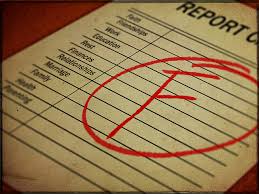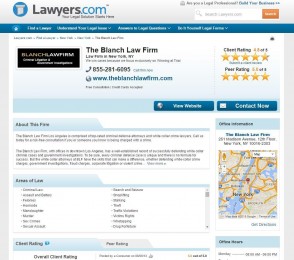Law firm review sites – your profile and dealing with negative comments
 In part one of reputation management basics, I laid out some of the reasons why it’s important to establish your presence in legal directories and on review websites. To follow up on that foundation, I’m going to cover what should be included in a legal profile and what to do when you find less-than-flattering reviews and comments on these sites.
In part one of reputation management basics, I laid out some of the reasons why it’s important to establish your presence in legal directories and on review websites. To follow up on that foundation, I’m going to cover what should be included in a legal profile and what to do when you find less-than-flattering reviews and comments on these sites.
First, sign up for at least of few of the most respected legal directories and claim your profile on any review sites (like Superpages, Yellowpages, Yelp, and Citysearch). These are the main sites I mentioned before:
Claiming and Completing Your Listings
When you claim your practice listing and complete your profile, be sure to include all relevant information.
- Upload your firm’s banner image
- Complete all contact information fields
- Include all practice areas
- Think of these digital profiles as your online brag-walls and post your awards, accolades, and achievements along with any news pieces to your profile
A good example of a rich profile belongs to The Blanch Law Firm on Lawyers.com.
Notice in this example that the profile has all of the information fields completed, as well as a thorough and detailed description of the firm and a detailed listing of their areas of practice. Lawyers.com places client ratings and peer ratings at the top of the page, in a way that attracts the user’s eye. The profile has a map with directions, the history of the firm, as well as an expandable list of reviews, ratings, and comments.
Claiming and completing these profiles will only benefit you in the long run. While you don’t have to claim a listing or fill out the profile information for your clients to leave reviews of your firm and services, it behooves you and the reputation of your firm to be proactive and use these sites to your advantage.
Negative Comments are Inevitable
It’s impossible to satisfy everyone. Just about anyone who has been active on the Internet has had to deal with negative comments. When you come across a negative review or comment, your first thought might be to defend yourself, to give your side of the story. While there are no hard and fast rules about dealing with negative content on the web, the last thing you want is to invite discussions that are inappropriate to share on the web. You don’t need to use a review site to stage a possibly long and drawn out heated discussion. In fact, negative reviews can be an opportunity to improve the situation with that particular client and show potential clients that you pay attention to their concerns (and that you care enough to work something out).
This doesn’t mean that you need to apologize for your service. Nor does it mean that you don’t defend your firm against bogus allegations or from angry rants. Turning a negative comment or review into a positive outcome is as simple as leaving a public comment inviting the dissatisfied commenter to call you at the office and talk to you about their grievances. After the phone call, go back to the site and leave another comment explaining how the situation was dealt with and that you were happy to discuss the issue and to be able to work together with the client to reach an understanding.
Use Tools to Help You Keep Your Ear to the Ground
The frequency of checking listings and review sites depends on your circumstance, your Internet marketing and promotion goals, as well as the time you are realistically willing to invest in managing your online reputation. As a general rule of thumb, it’s best to reply to comments and postings as soon as you can or at least within a relatively short time frame. That means checking these sites at least a couple of times each week. I know, I know, who has time for that? Be aware that most review sites will have some sort of tool that allows you to be notified when comments or reviews are left, allowing you to go to the site only when needed.
Monitoring Your Brand – Beyond Directories and Review Sites
Most busy professionals begrudge the additional time requirements reputation management demands. However, there are tools that will monitor the web for mentions of your name or brand and give you these results in graphs, infographics, and images for quick reference and response actions. Some of these tools have subscription costs, others are available for free. A few give in-depth results from across the web while others may be limited to data collected from their own services or platforms. You can simply do a search for tools to monitor brand mentions to find numerous options.
If you want a more hands-on approach, and you don’t mind a potentially busy inbox, you can subscribe to RSS feeds for the sites you value most to hear if your name is being mentioned. If you blog, be sure to turn on comment notifications. If you guest blog, answer the first comment and turn on reply notifications.
You can also set up alerts for your name mentions through a variety of aggregate news sources (Google, Bing, and Yahoo News). These may not pull in social media and some other types of mentions, but you’ll get a glimpse at some of them.
The bottom line is that you need to be monitoring legal directories and review sites as well as listening for mentions of your name and brand from elsewhere on the web. You don’t have to read every comment or review, nor do you have to respond to all of them, negative comments included. Just make an effort to start listening and slowly grow from there. This isn’t a race, rather it’s a new and more personal way to be involved with your clients and in control of your reputation online.
Teresa Shaw is an SEO expert with 10 years experience helping attorneys and law firms across the country increase public awareness of their services.


Comments
I loved your article post.Thanks Again. Want more.
Hello, TERESA SHAW! your guide on Law firm review sites – your profile and dealing with negative comments is amazing People who leave a review for the wrong attorney.But you have shared step by step guide on how to handle the situation should you get a bad review
Leave a Reply